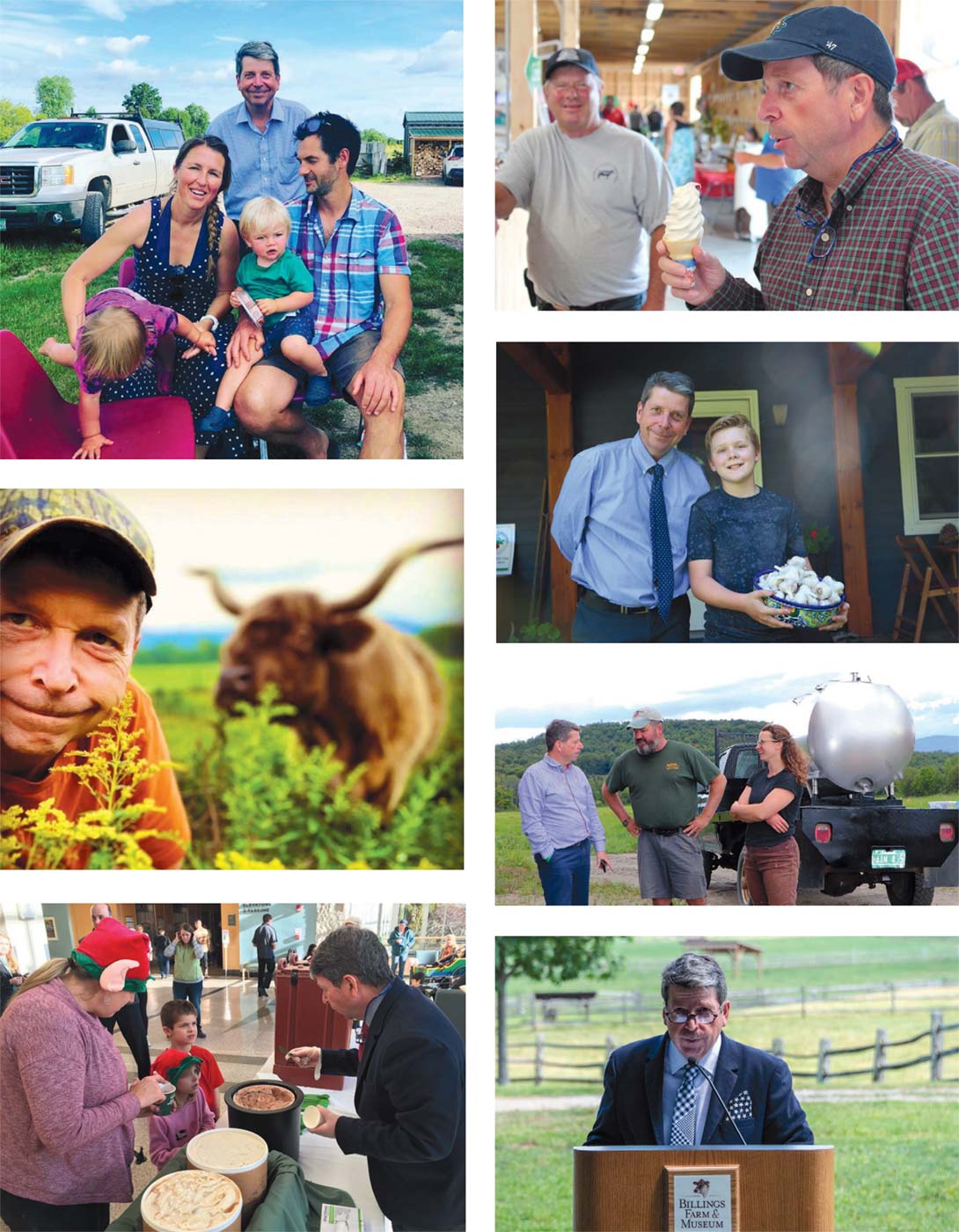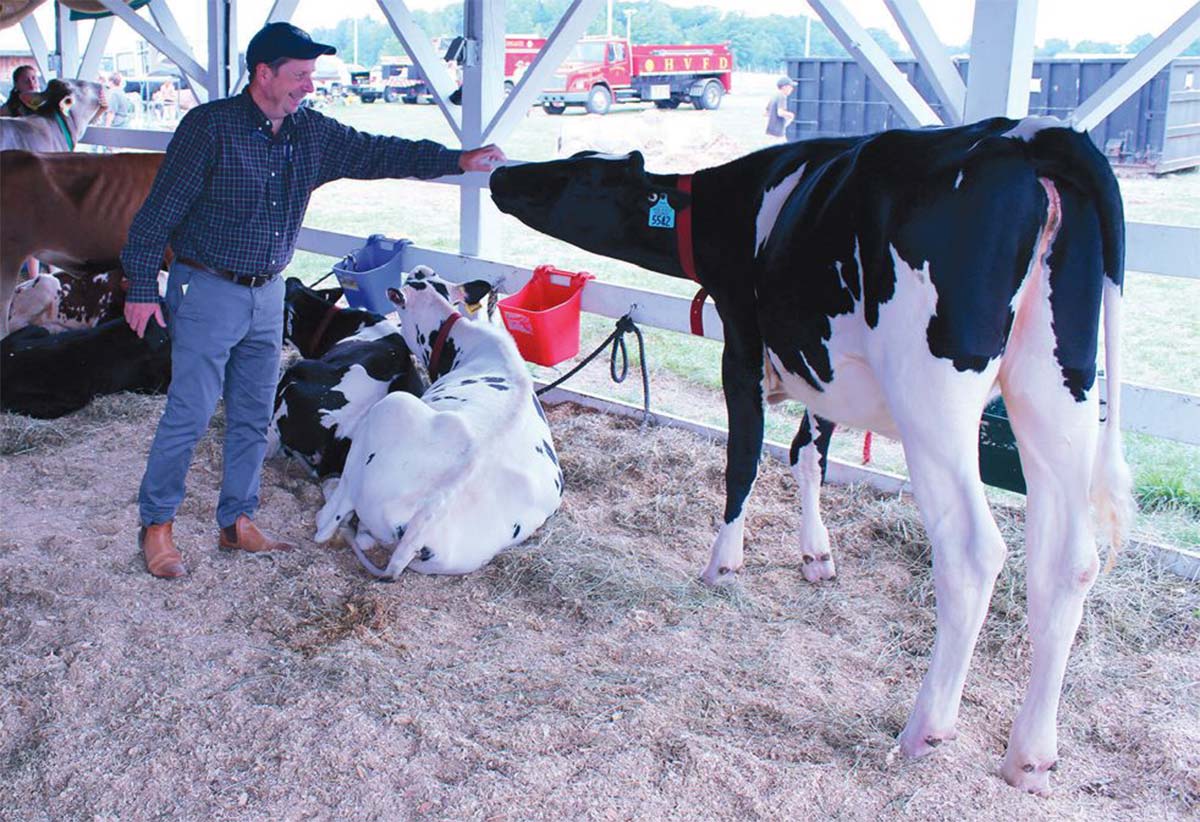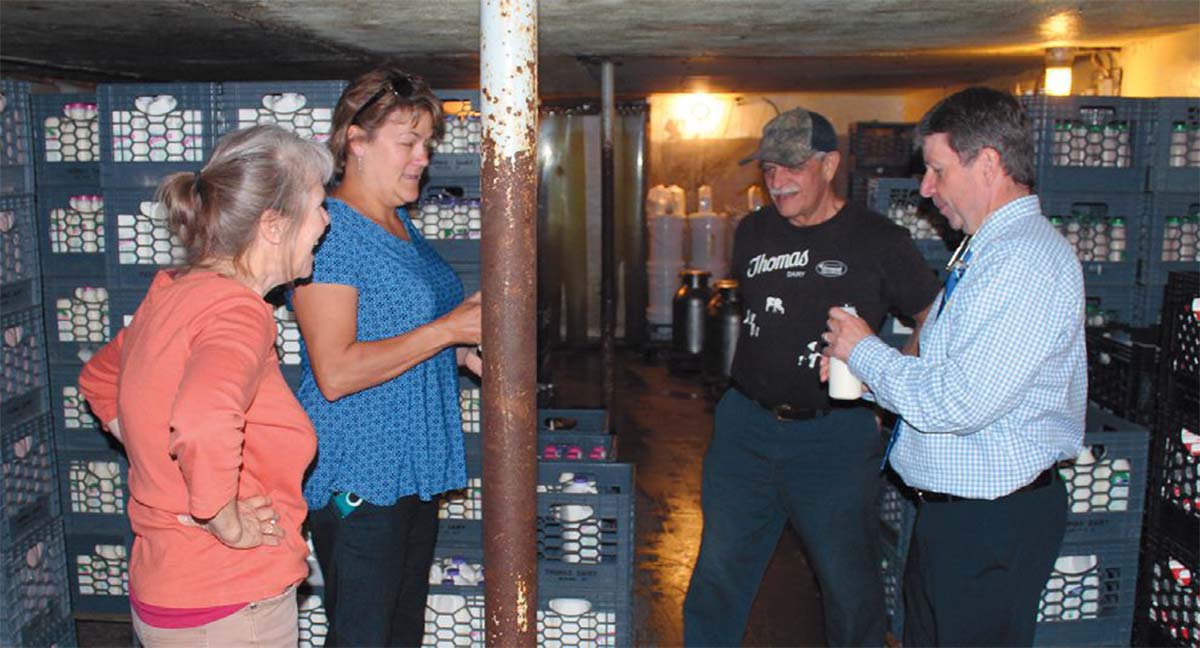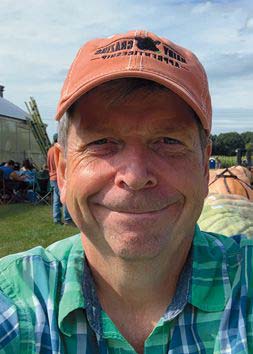Anson Tebbetts - Vermont's Secretary of Agriculture Food, and Markets

“Vermont is blessed
with innovative
farmers and
producers who are
focused on quality.”
–Anson Tebbetts
As Vermont’s Secretary of Agriculture, Food, and Markets, Anson Tebbetts has a lot on his plate to ensure that we Vermonters have a lot on our own plates. His days, and probably nights, revolve around supporting our farmers, protecting animal health and water quality, monitoring invasive pests such as the emerald ash borer, maintaining market standards, and promoting Vermont products and producers. Where did our Secretary of Agriculture learn to balance so many responsibilities? Read on and see!
Tell us about your early career at WDEV radio and then as news director at WCAX. Anson Tebbetts: My life seems to merge cows and cameras. I grew up on a dairy farm in Cabot so I would listen to the radio while milking cows. Red Sox, the news, talk shows at night, WDEV in Waterbury, WBZ Boston. I went to Emerson College in 1983 to study broadcasting. Being close to Fenway Park didn’t hurt. Radio and television had lots of opportunities back then. WDEV hired me in 1987 as a copywriter and then I was promoted to reporter. I had loads of fun, covering various events throughout Vermont for six or seven years. I switched to WCAX’s Rutland bureau in 1994. Living there introduced me to southern Vermont. For 14 years, I covered the State House while Governors Kunin, Dean, and Douglas were there.

Anson Tebbetts, Vermont’s Secretary of Agriculture, Food, and Markets, connects with people all around the state, serving our community in more ways than one.
And you were appointed Deputy Secretary of Ag under Roger Albee in 2007?
AT: I’ve always been invested in rural interests, so some folks thought I’d be good in that role. Those two years taught me a lot about state government. Governor Scott appointed me as Secretary in January 2017.
How does your experience in journalism help you in your current role?
AT: Journalism is storytelling. I tell our farmers and producers that they really need to share their stories. The public wants to know about them, their product, how it’s produced, where it’s grown, how they take care of their animals and tend the land. And the Ag Agency needs to tell people where their money is going, how and why their tax dollars are being invested in various programs. Part of our mission is to ensure we have good customer service, communicate with our public and with our farmers and producers.
Being raised as a farm kid must shape who you are today.
AT: That’s right. I learned how to put in a good day’s work—milking cows, working with sheep, sugaring. Not every day was wonderful, but there were tremendous rewards. Farm kids gain practical experience by taking care of animals, land, and equipment. Knowing the rhythms and routines of a farm—and the enormous pressures farmers face—keeps me grounded, and I always come back to those memories when I’m working on regulations.
How has agriculture changed, for the worse and for the better, in the last two decades?
AT: Across the nation, there’s been consolidation of farms and efficiencies because of the public’s demand for a cheap food supply. The economies of scale dictate growth, and a business has to decide whether to serve a niche market or scale up.
On the positive side, so many creative people are striving to create value-added products. Vermont is blessed with innovative farmers and producers who are focused on quality. Our farmers produce some of the best milk in the United States, and our producers transform that into cheese, butter, yogurt, cottage cheese, and ice cream. That process starts with the farmers’ dedication and care for their animals.
We have some of the best farmers’ markets in the country right here. Restaurants are focused on buying as much local product as they can. The trend is on the upswing since the pandemic as more people are focused on the regional and local food system.
What can Vermonters do to help support our farmers and producers?
AT: If you can, buy as much local as possible. And try to understand the challenges and pressures people face who make a living from the land. Animals may get out, smells sometimes drift, and tractors move slowly on the roads. Be patient with all of these. Get to know your farmers, forge connections, and learn about the issues they face. And say thank you—many farmers open their land to hunting, fishing, and snowmobiling.

Once a farm boy, always a farm boy…
Why has the Vermont brand in value-added products become the gold standard?
AT: Quality is so important for everything we do in Vermont. We’re not the biggest, but we can be the best. And it’s based on creative, high-quality products. If you’re making a cheese, it has to start with the best milk, and that’s where the magic begins. We can say the same for maple. Our sugarmakers take so much care to collect and process the best syrup. It’s so much more than just drilling a hole in the tree and collecting the sap. The state has invested in research and technical assistance. We have stringent maple laws in place that ensure that brand stays strong. That’s why Vermont is number one in the nation in production and quality of maple. We produce 2 million gallons annually, which is half of all the pure maple produced in the United States. When you travel around the country and mention maple, Vermont is usually the second word.
How has the pandemic impacted farms and markets?
AT: On the positive, we’ve had a reset. More people have become invested in local food systems. Since the pandemic, more people have returned to the kitchen and are looking for local food—not only meats and produce but also local flour, butter, and cheese. It’s been a struggle to get those things processed, onto trucks and into stores. We need to double-down on our efforts to get the products to the consumers.
We’ve seen more farm stands pop up, more people are shopping at farmers’ markets, smaller co-ops, and supporting local farms. We’ve seen tremendous growth of more Vermont products being shipped through e-commerce. Again, our people have been nimble enough to move rapidly and change their business plans. I think that growth will continue.
What appeals to you about your job?
AT: The variety. Working with and getting to know farmers and producers. Trying to solve problems. I have a great team, and my staff has deep roots in ag and work hard to serve the public. I’m delighted to have the opportunity to connect with people who make a living off the land. It’s an honor to serve in this role.
What keeps you up at night?
AT: I worry about the mental health of our farmers and the stress they’re under. We’re standing up a program over the coming year that offers funding for mental health support. I just want to ensure our farmers have the resources they need if they want to talk to someone.
Labor concerns me. Agriculture cannot happen remotely. We need a steady supply of workers on farms and in facilities that process food, whether it be meat or cheese. And we need affordable housing near those processing plants. I worry about equitable access to affordable land, and transitioning farms as our farmers age. The average age of a Vermont farmer is 58. How can these folks afford to retire and pass down the business?
We have infrastructure needs—meatand dairy-processing plants, capacity for storage, aggregate shipping systems, and distribution sites instead of having trucks run all around the back roads as farms try to get products to bigger markets in the Northeast.
Talk about dairy.
AT: Dairy farmers are trapped in a federal system that needs an updated pricing system. Aside from two relatively good years in 2013 and 2014, milk prices paid to our farmers are really low. But we’ve seen steady growth in dairy processing, thanks to an increase in value-added products. Even though the number of farms has declined, production of milk remains steady, which means farmers continue to do a great job of getting more milk out of fewer cows, by taking such good care of their animals.
Let’s shift gears to your family!
AT: My wife, Vicky, was the former vice president of the Vermont Chamber of Commerce, and she’s now an independent contractor who does writing for her clients. We have two children, Alden Cabot who’s 18 and Adelie Hope who’s 15. I spend most of my time at our farm in Cabot, and Vicky has the kids in South Burlington for education and the soccer world. We spend most weekends together in South Burlington.
Describe an ideal weekend in the Tebbetts’ household.
AT: Eating lots of cheese and crackers. Doing things together at home, such as cooking, hiking or walking, watching a movie. We have a garden in Cabot and a plot at Common Roots. I start out okay and then the weeds somehow get ahead of me. I love cut flowers such as sunflowers and zinnias. Last year I experimented with sweet peas and they did pretty well. I got the seeds from Bailey Hale at Ardelia Farm. I just joined the Vermont Giant Pumpkin Growers Association. I went to their big weigh-in last October and got hooked. I always wanted to do it so I took the plunge. I ordered my seeds this past winter and hope to get them in the ground this summer. Apparently, it’s an addictive hobby so we’ll see what happens!
You’re an avid bird watcher—how did that evolve?
AT: I was in the 4-H Club as a kid in the 1970s. My neighbor was an ornithologist and a dairy farmer. She’d round us up and we’d watch birds. We would travel the back roads and identify birds. Birding has become one of the world’s top hobbies.
And you’ve kept a hand in at WDEV with your Saturday morning radio show, “For the Birds.”
AT: I started the show 27 years ago with Bryan Pfeiffer; I now co-host it with Chip Darmstadt. Someone called the radio station in 1995 and asked for help identifying a bird she’d seen. So we opened the phone lines, and 25 people called in to help identify the bird. That evolved into our 10-minute show. We come up with a theme each week based on bird sightings or whatever strikes us. It’s still a fun project for me that I love doing. You can find archived shows on the WDEV website.
Words of advice for folks involved at any level in Vermont agriculture?
AT: Listen. Learn from your neighbors. Reach out to those who have plowed some ground for you already. Search for the sunrise every morning, and have faith that today will be better than the day before.

Anson Tebbetts visiting Thomas Dairy in Rutland

These giant pumpkins from last October inspired Anson Tebbetts to grow his own this summer.
KEY VERMONT DAIRY STATISTICS
Provided by Diane Bothfeld, Vermont Agency of Agriculture, Food, and Markets
Number of Dairy Cow Farms
2012: 972
2021: 572
Average Number of Cows per Farm
2012: 138
2021: 210
Dairy Processors
2012: 83 (54 on-farm, 29 off -farm)
2021: 158 (70 on-farm, 88 off -farm)
Dairy Cow Farms by Size
Large Farm Operations (more than 700 cows)
2012: 17
2021: 35
Medium Farm Operations (200 to 699 cows)
2012: 145
2021: 95
Small Farm Operations (less than 200 cows)
2012: 810
2021: 669 (includes 216 certified small organic operations)
Top Three Dairy Counties in 2021
Franklin County:
109 dairy farms
Orleans County:
93 dairy farms
Addison County:
88 dairy farms
Two Smallest Dairy Counties in 2021
Bennington County:
10 dairy farms
Grand Isle County:
9 dairy farms

5
rapid fire questions
for ANSON TEBBETTS
Typical breakfast?
I hit the coffee pot first. Hot coffee with maple syrup.
Sometimes a couple of fried eggs.
Favorite childhood meal?
Mac and cheese. Scalloped potatoes and ham.
Cake, pie, or cookies?
Pie. Maple cream or pumpkin.
Guilty pleasure in food or drink?
Smoked maple Manhattan. Black raspberry or vanilla ice
cream with maple syrup.
Late-night snack?
Vanilla Greek yogurt with—you guessed it—maple.




